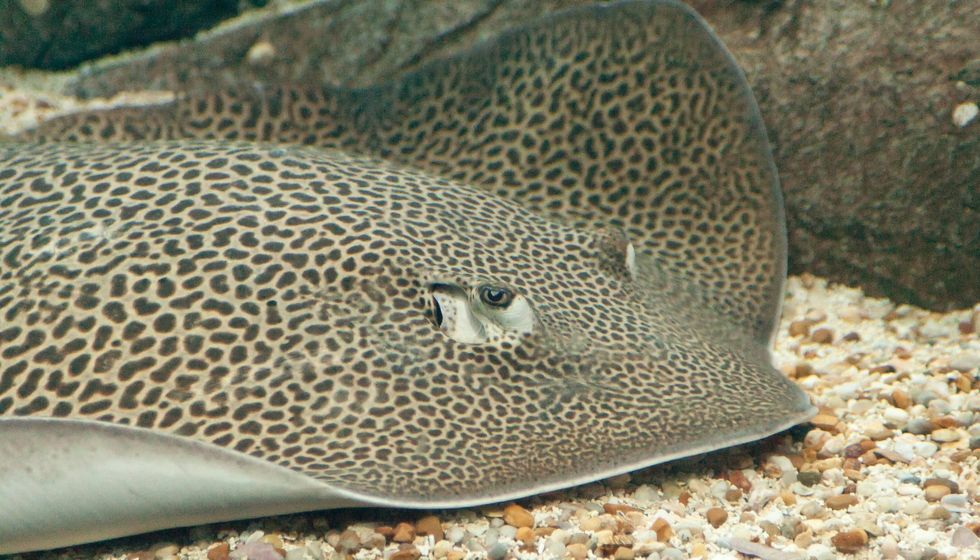Are you fascinated by ray fish, like the eagle ray? Then here we have all the information on the honeycomb stingray.
The honeycomb stingray (Himantura uarnak) species belongs to the Dasyatidae family of animals. They are also known as the reticulate whipray. The geographic range of this ray species is pretty widespread in the Indo-Pacific Oceans.
They can be seen from the Philippines to South Africa and from Syria southwards to Israel and Egypt. This whipray has dark or brown and black reticulate patterns on the dorsal side of its body. This is where they got their name, reticulate whipray.
This whipray has a long tail, which is about three times the length of its body. This whipray can be venomous and they can sting you if they feel threatened by you in any way.
Read on to know more about the reticulate whipray and if you like this article, then also check out giant freshwater stingray and manta ray.
Honeycomb Stingray Interesting Facts
What type of animal is a honeycomb stingray?
The reticulate whipray or honeycomb stingray (Himantura uarnak) is a species of ray, or more specifically, stingray.
What class of animal does a honeycomb stingray belong to?
The reticulate whipray species belongs to the family Dasyatidae and class Chondrichthyes of animals.
How many honeycomb stingrays are there in the world?
The population of this whipray in an exact number is not known. However, their population trend has been seen to be decreasing in their habitat range mainly due to excessive fishing.
Where does a honeycomb stingray live?
The geographic distribution of this species of rays in the Indo-Pacific Ocean is pretty widespread. They can specifically be seen in the west-central Pacific Oceans and west and east Indian Ocean.
These are migratory fish. They travel from the Red Sea through the Suez Canal to the Mediterranean Sea. These fish are found from the Philippines to South Africa and from Syria southwards to Israel and Egypt.
What is a honeycomb stingray's habitat?
The primary habitat of this ray species is subtropical and tropical waters. They prefer sandy areas of rock and coral reefs, sandy beaches, intertidal lagoons, shallow estuaries.
This stingray is mainly considered a marine species, but they often do occur in freshwater habitats. Although they prefer shallow water, they can swim to a depth of at least 164 ft (50 m).
Who do honeycomb stingrays live with?
Most stingrays are known to be solitary in nature. We can assume that honeycomb stingrays behave the same way as well.
How long does a honeycomb stingray live?
The exact lifespan of this species of rays is not known. However, stingrays, in general, live for 15-25 years on average in the wild. We can assume that the honeycomb stingray also lives within that age range.
How do they reproduce?
Due to a lack of research, very little is known about the reproductive process of these rays. However, young pups have been seen to be born around the summer and these stingrays start mating soon after.
These fish have been observed to be ovoviviparous. They show viviparous nature with histotrophy which is when the embryos feed off yolks in the beginning.
They then receive nutrition from the mother by feeding off the uterine fluid, which is enriched with protein, fat, and mucus. The female gives birth to three to five pups on average.
What is their conservation status?
The conservation status of the reticulate whipray, according to the International Union for Conservation of Nature, is listed as Endangered. The continued decrease in the population of this stingray in their habitat range is caused by direct and bycatch fisheries in coastal areas.
Many countries in the Indo-Pacific habitat range depend highly on the fishing of sharks and rays, leading to these stingrays falling victims to fishing expeditions on a large scale. They also fall victim to pollution and habitat degradation.
Honeycomb Stingray Fun Facts
What does the honeycomb stingray look like?
The honeycomb stingray (Himantura uarnak) or the honeycomb-patterned stingray is a big-sized stingray. They are disc-shaped with a slender, long tail that takes up about 3/4th the size of their body and a pointed nose.
They usually have one sting, which is located near the base of their tail. The sting is an extremely modified denticle that contains sharp edges that look like a saw-tooth. On their dorsal side, they have big reticular-shaped dark spots or brown and black patterns on a yellow to beige-brown background.
Their ventral side is a shade of white. Behind the sting, they have white and black bands on their tail.
How cute are they?
These ray fish can be considered pretty cute. However, they pack a painful punch if they pinch you with their sting. It is best to admire this ray from a far distance.
How do they communicate?
Stingrays use special senses to search for prey. They have eyes on their dorsal side and the mouth on their ventral side. To help find their prey, they have pits on the front of their faces that are gel-filled. These pits pick electric signals from other marine animals and sense their prey.
How big is a honeycomb stingray?
An adult reticulate whipray or honeycomb stingray biggest or maximum size can be about 63 in (160 cm) in disc width and 137.8 in (350 cm) in length. A juvenile pup is about 8.3-11 in (21-28 cm) in disc width and 35.4 in (90 cm) in length.
They are a little larger than cownose rays, which are about 43.3 in (110 cm) in length.
How fast can a honeycomb stingray swim?
The exact speed at which these rays swim is known. However, they have been seen to swim near the sandy substrate with the help of their disc-shaped pectoral wings at a moderate pace.
How much does a honeycomb stingray weigh?
These are big-sized ray fish. An adult honeycomb stingray or reticulate whipray is about 264.5 lb (120 kg) on average.
What are the male and female names of the species?
The males and females of this species of whipray have no specific names.
What would you call a baby honeycomb stingray?
A baby honeycomb stingray or reticulate whipray is called a pup or fry.
What do they eat?
These ray fish are carnivorous in nature. They wander around the bottom of the sea and prey on small fish and invertebrates, like shrimps, crabs, worms, sea jellies, and bivalves.
Are they dangerous?
These rays can be dangerous and aggressive, so it is best to admire them from a distance.
Would they make a good pet?
These rays don't make good pets. They can be dangerous and their sting can seriously harm a person. This is why it is better to leave them in their natural habitats.
Did you know...
The reticulate whipray has spiracles on its dorsal side which help the fish breathe in the water when the fish is hiding buried in the sand. It also prevents the fish from inhaling sand.
The genus Himantura of the reticulate whipray has some little-known species of stingray fish, like the leopard stingray and the marbled stingray. These three species have a similar shape, but the leopard stingray has dark brown spots, and the marbled stingray has reticulate brown patches on a light-colored background.
Do stingrays sleep?
Yes, stingrays sleep under the sand with only their eyes visible.
How does a stingray's tail work?
If a stingray feels threatened by a human or animal, it will raise its tail and strike with its spine, which is the dentin surface of its sting. The venom enters the skin of the potential threat and the saw-like tooth broadens the wound of the threat.
Here at Kidadl, we have carefully created lots of interesting family-friendly animal facts for everyone to discover! For more relatable content, check out these giant guitarfish facts and giant frogfish facts for kids.
You can even occupy yourself at home by coloring in one of our free printable manta ray coloring pages.
Second image by Aurimas Mikalauskas from Paliūniškis, Lithuania.










